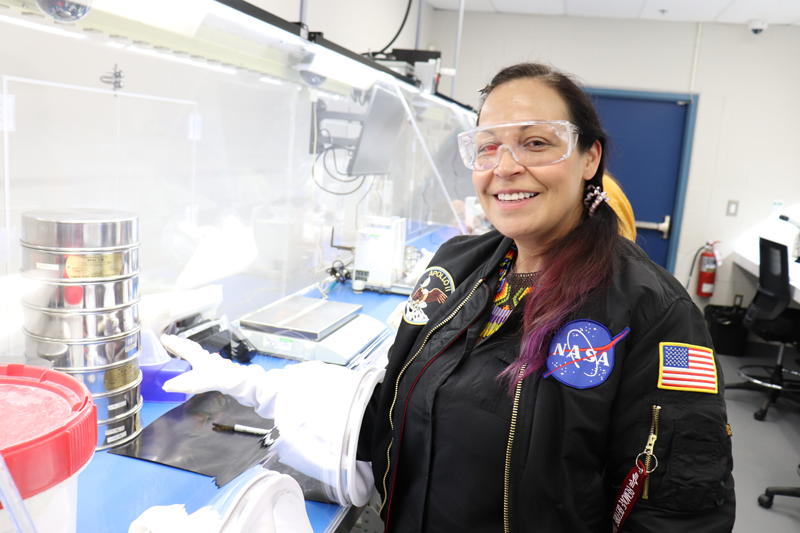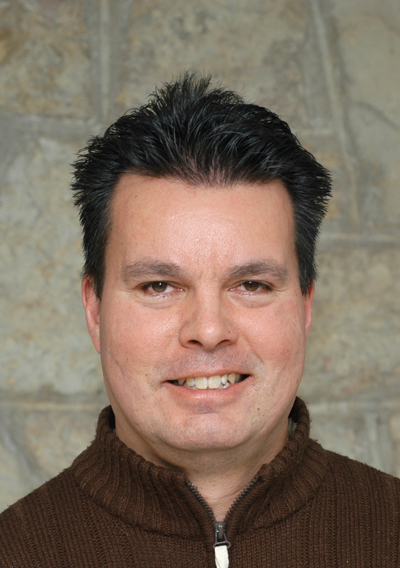
‘A trailblazer and role model for Indigenous women in science’: USask graduate honours her heritage through new STEM business
Dawn Pratt’s (MSc'11) career path was set early in life, after her parents bought her a child’s chemistry kit in Grade 4.
By Shannon BoklaschukThose rudimentary science experiments helped foster in Pratt a decades-long passion for science, technology, engineering and mathematics (STEM).
“My parents bought me a chemistry kit and I loved it,” she said. “I went on to study chemistry when I went to university. My path started at a very young age, and I was just very adamant that I loved chemicals and science and microscopes. It was like a playground to me.”
Today, Pratt—a University of Saskatchewan (USask) graduate and member of the Muscowpetung Saulteaux Nation—is the founder of Askenootow STEM Enterprise Inc. She started the business just over a year ago, “so my people can see that we have our own Indigenous professionals” within the STEM fields, she said.
“It would be Indigenous-owned, Indigenous-created, and all the content would be Indigenous STEM-created content,” Pratt said of her vision for Askenootow.
During the past year, Pratt has been busy getting her business off the ground by building partnerships and handling a wide variety of tasks, such as creating business cards and a website.
“Every little thing takes time,” she said. “I’m doing this on my own right now because I’m just starting. Eventually I would like to have partners. I know Indigenous STEM professionals, so maybe I could bring them on somehow through some kind of contract. I’m still trying to work out that part, but I have a general idea of wanting to bring in more Indigenous STEM professionals somehow or some way.”
Through Askenootow, Pratt is currently working as a consultant for the Federation of Sovereign Indigenous Nations (FSIN) on various projects. She had originally planned to go into schools to deliver Indigenous STEM content, but due to the COVID-19 pandemic she’s been working virtually.
“Right now, I help with delivering professional development to educators working in First Nations schools in Saskatchewan. So that would be one of the things I do with the federation, one of the projects I work with,” she said. “I’m also helping them build a strategic plan in STEM outreach.”
Askenootow is the Cree name of one of Pratt’s relatives who spoke three languages and was an interpreter for Treaty Four. Askenootow’s English name was Charles Cowley Pratt, and he was born in 1816 and died in 1888.
“It was my great-great-great-grandfather’s name,” Dawn Pratt said of Askenootow. “It’s kind of a way to honour your ancestors.”
Drawing inspiration and strength from her cultural heritage, Pratt shares her passion for science and the environment with everyone around her.
Her post-secondary education in science came after graduating from high school in Regina, where she enrolled in courses at the First Nations University of Canada and the University of Regina, earning a Bachelor of Science degree in chemistry with a minor in mathematics.
Pratt then the came to the University of Saskatchewan for graduate studies, earning a Master of Science (MSc) degree in chemistry at USask in 2011. She was supervised by Dr. Lee Wilson (PhD), a faculty member in the Department of Chemistry in USask’s College of Arts and Science, and Dr. Janusz Kozinski (PhD), a former dean of the College of Engineering.
Pratt’s MSc research focused on the design of organic adsorbent materials that were directed toward the removal of arsenic from contaminated water, resulting in a thesis entitled “Sorption of Arsenic Species using Chitosan-Based Biopolymer Sorbent Materials.” Her research resulted in several peer-reviewed publications, including two first-authored and three co-authored papers.

“Dawn brought new energy to the lab, and I enjoyed the opportunity to work with her and witness her development as an Indigenous student working in the sciences,” said Wilson, a USask graduate who earned his PhD in chemistry in 1998. “Dawn was comfortable with mathematics and brought a fresh perspective to my lab through her First Nations perspective and worldview.”
Wilson, a Métis scholar from Manitoba who has mentored numerous Indigenous students, said he felt fortunate to be Pratt’s supervisor during her MSc degree. He noted that her “ability to overcome obstacles is a reflection of the hard-working ethic instilled by her family upbringing and belief in the importance of her Aboriginal identity.”
“I was very pleased that she completed her MSc degree successfully and, to my knowledge, she is one of the first female First Nations students to have completed a graduate degree in chemistry,” Wilson said. “Since that time, other students have followed—and this is important to note, because she can be viewed as a trailblazer and role model for Indigenous women in science.”
Pratt was active in numerous extra-curricular activities on the USask campus during her time as graduate student. Notably, she piloted the Science Ambassador Program in 2007. A highlight of the Science Ambassador Program, which continues today, is that it connects northern Indigenous communities with USask by pairing senior undergraduate and graduate students with schools across northern Saskatchewan for four to six weeks each spring.
“It’s rewarding to follow the journeys that our science ambassadors take after serving the program, including their continued efforts to support community-minded projects years later. Our ambassadors often become leaders, and Dawn is no exception,” said Lana Elias, director of science outreach in the College of Arts and Science.
“As we work together towards Reconciliation, there is growing demand from both Indigenous and non-Indigenous educators for authentic Indigenous STEM resources. Dawn’s ability to see the world through both Indigenous and Western science perspectives, and communicate content at a variety of levels, is a gift. How exciting that she is willing to share that through Askenootow.”
From her own experiences growing up, Pratt observed that there weren’t enough Indigenous role models in STEM. She wanted to help change that, and to inspire Indigenous youth and females to explore the STEM fields as a career option.

At USask, Pratt became involved in MentorSTEP, which supports Indigenous women and girls who are interested in STEM and related business, health and environmental studies. Pratt is now encouraging other Indigenous women in STEM “to put yourself out there” and become a role model for youth.
“I didn’t have Indigenous STEM role models to look up to,” she said. “I knew who Albert Einstein was, and famous male scientists, but I never had an Indigenous STEM role model or mentor. So I just think it’s really important for myself to be out there so people can see that, ‘Oh, she’s Indigenous, she’s female and she’s a chemist.’ ”
Since earning her first university degree, Pratt has taken on many career opportunities related to science and to her passion for protecting the environment. For example, after completing her bachelor’s degree, she moved to Ottawa to work as a nuclear fuel waste management dialogue coordinator for the Assembly of First Nations (AFN). She has also worked with the Saskatoon Tribal Council (STC) and the Saskatchewan Indian Institute of Technologies (SIIT).
Through her new business, Pratt hopes she can inspire Indigenous youth and females to learn more about STEM subjects. As the mother of two young girls, ages nine and 10, Pratt is also committed to mentoring them in science and mathematics. She actively seeks to bring science to life for her daughters by taking them on trips to educational places, such as the NASA Space Center Houston in Texas.
“There’s so much opportunity out there now if you’re thinking of a STEM career,” Pratt said. “I didn’t have those opportunities when I was younger. I wasn’t even in a science fair when I was younger. . . . But there’s so many opportunities now, and it’s just so great to see all the opportunities.”
Article originally published at https://artsandscience.usask.ca.

